-
Countries
-
Data and Analysis
-
Special Focus
-
Crisis Responses
Contact
DTM Yemen, iomyemendtm@iom.int
Location
Yemen
Activity
- Mobility Tracking
- Event Tracking
Period Covered
Jan 22 2023 -Jan 28 2023
From 1 January to 28 January 2023, IOM Yemen DTM tracked 898 households (HH) (5,388 Individuals) who experienced displacement at least once.
Between 22 and 28 January 2023, IOM Yemen DTM tracked 160 households (960 individuals) displaced at least once. The majority of people moved into/within the following governorates and districts:
- Abyan (47 HHs) – Mudiyah (47 HHs) district. All displacements in the governorate were internal.
- Marib (42 HHs) – Marib City (36 HHs), Marib (6 HHs) districts. Most displacements in the governorate originated from Marib and Al Hodeidah.
- Taiz (31 HHs) – Al Mudhaffar (17 HHs), Al Makha (13 HHs), Al Maafer (1 HHs) districts. Most displacements in the governorate were internal.
- Abyan (47 HHs) – Mudiyah (47 HHs) district.
- Taiz (27 HHs) – Maqbanah (20 HHs), Jabal Habashi (3 HHs), Hayfan (2 HHs) districts.
- Lahj (26 HHs) – Al Qubaytah (26 HHs) district.
Population Groups
Survey Methodology
Unit of Analysis Or Observation
Type of Survey or Assessment
Keywords
Geographical Scope
Administrative boundaries with available data
The current dataset covers the following administrative boundaries
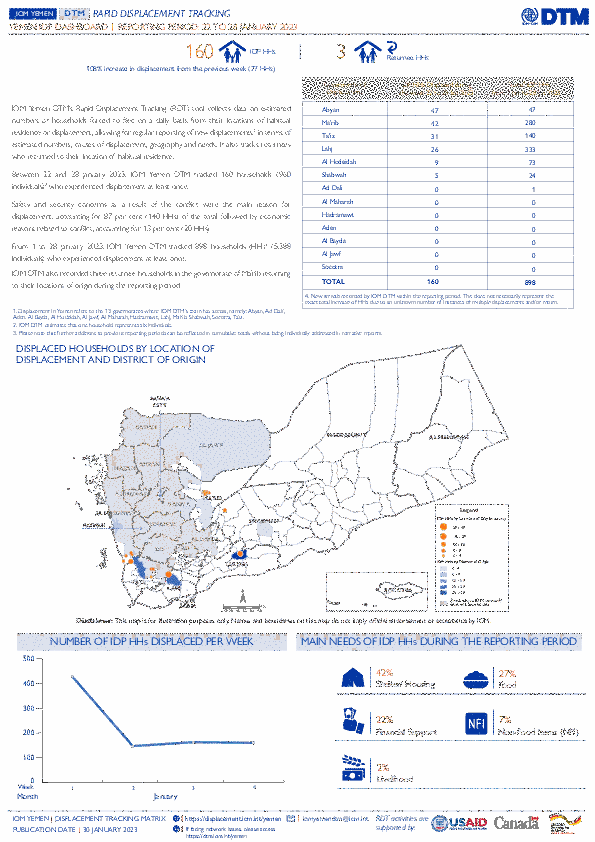
Contact
DTM Yemen, iomyemendtm@iom.int
Language
English
Location
Yemen
Period Covered
Jan 22 2023
Jan 28 2023
Activity
- Mobility Tracking
IOM Yemen DTM’s Rapid Displacement Tracking (RDT) tool collects data on estimated numbers of households forced to flee on a daily basis from their locations of origin or displacement, allowing for regular reporting of new displacements in terms of estimated numbers, geography, and needs. It also tracks returnees who returned to their location of origin.
From 1 January to 28 January 2023, IOM Yemen DTM tracked 898 households (HH) (5,388 Individuals) who experienced displacement at least once.
Between 22 and 28 January 2023, IOM Yemen DTM tracked 160 households (960 individuals) displaced at least once. The majority of people moved into/within the following governorates and districts:
- Abyan (47 HHs) – Mudiyah (47 HHs) district. All displacements in the governorate were internal.
- Marib (42 HHs) – Marib City (36 HHs), Marib (6 HHs) districts. Most displacements in the governorate originated from Marib and Al Hodeidah.
- Taiz (31 HHs) – Al Mudhaffar (17 HHs), Al Makha (13 HHs), Al Maafer (1 HHs) districts. Most displacements in the governorate were internal.
The majority of people moved from the following governorates and districts:
- Abyan (47 HHs) – Mudiyah (47 HHs) district.
- Taiz (27 HHs) – Maqbanah (20 HHs), Jabal Habashi (3 HHs), Hayfan (2 HHs) districts.
- Lahj (26 HHs) – Al Qubaytah (26 HHs) district.
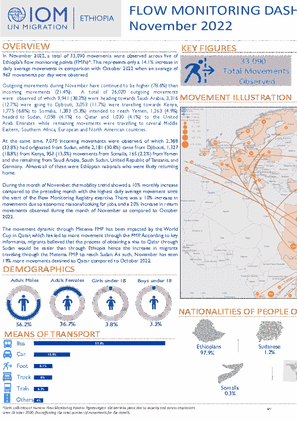
Contact
DTM Ethiopia, DTMEthiopia@iom.int
Language
English
Location
Ethiopia
Period Covered
Nov 01 2022
Nov 30 2022
Activity
- Flow Monitoring
In November 2022, a total of 33,090 movements were observed across five of Ethiopia's flow monitoring points (FMPs). This represents only a 14.1% increase in daily average movements in comparison with October 2022 when an average of 967 movements per day were observed.
Outgoing movements during November have continued to be higher (78.6%) than incoming movements (21.4%). A total of 26,020 outgoing movements were observed of which 9,941 (38.2%) were heading towards Saudi Arabia, 3,316 (12.7%) were going to Djibouti, 3,053 (11.7%) were travelling towards Kenya, 1,775 (6.8%) to Somalia, 1,383 (5.3%) intended to reach Yemen, 1,263 (4.9%) headed to Sudan, 1,058 (4.1%) to Qatar and 1,030 (4.1%) to the United Arab Emirates while remaining movements were travelling to several Middle Eastern, Southern Africa, European and North American countries.
At the same time, 7,070 incoming movements were observed, of which 2,388 (33.8%) had originated from Sudan, while 2,181 (30.8%) came from Djibouti, 1,327 (18.8%) from Kenya, 953 (13.5%) movements from Somalia, 165 (2.2%) from Yemen and the remaining from Saudi Arabia, South Sudan, United Republic of Tanzania, and Germany. Almost all of these were Ethiopian nationals who were likely returning home.

Contact
DTM Haiti, dtmhaiti@iom.int
Language
English
Location
Haiti
Period Covered
Jan 24 2023
Jan 25 2023
Activity
- Mobility Tracking
- Event Tracking
A fire broke out on 23 January 2023 in the neighborhood of Fort-National (1st Section Turgeau, Municipality of Port-Au-Prince, West district) following an incineration of waste in the open air. As a result, 29 households (140 individuals) were displaced after their houses were destroyed. Among these households, 24 took refuge with host families in the same neighborhood while 5 took refuge in a nearby drinking establishment.
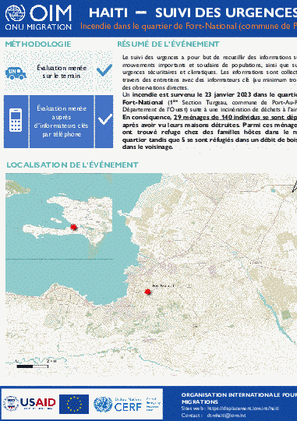
Contact
DTM Haiti, dtmhaiti@iom.int
Language
French
Location
Haiti
Period Covered
Jan 24 2023
Jan 25 2023
Activity
- Mobility Tracking
- Event Tracking
Un incendie est survenu le 23 janvier 2023 dans le quartier de Fort-National (1ère Section Turgeau, commune de Port-Au-Prince, Département de l’Ouest) suite à une incinération de déchets à l’air libre. En conséquence, 29 ménages de 140 individus se sont déplacés après avoir vu leurs maisons détruites. Parmi ces ménages, 24 ont trouvé refuge chez des familles hôtes dans le même quartier tandis que 5 se sont réfugiés dans un débit de boissons dans le voisinage.
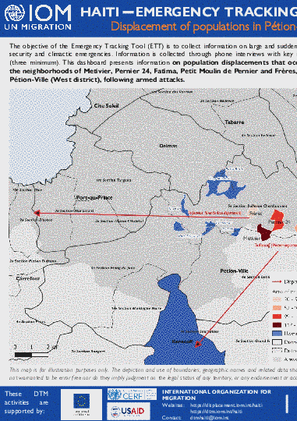
Contact
DTM Haiti, dtmhaiti@iom.int
Language
English
Location
Haiti
Period Covered
Jan 20 2023
Jan 24 2023
Activity
- Mobility Tracking
- Event Tracking
An attack by armed persons took place on 20 January 2023 in the municipality of Piétion-Ville (West district), mainly in the Metivier neighborhood. This event caused the displacement of approximately 261 households (1,088 individuals).
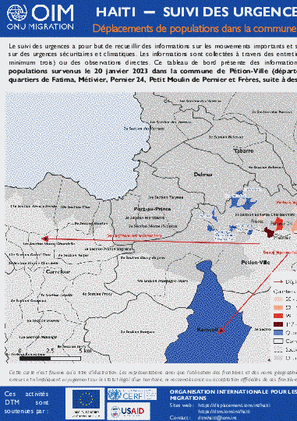
Contact
dtmhaiti@iom.int
Language
French
Location
Haiti
Period Covered
Jan 20 2023
Jan 24 2023
Activity
- Mobility Tracking
- Event Tracking
Une attaque des personnes armées est survenue le 20 janvier 2023 dans la commune de Piétion-Ville (Département de l’Ouest), principalement dans le quartier de Metivier. Cet événement a provoqué un déplacement d’environ 261 ménages comprenant 1 088 individus.

Contact
DTMMozambique@iom.int
Language
English
Location
Mozambique
Period Covered
Jan 18 2023
Jan 24 2023
Activity
- Mobility Tracking
- Event Tracking
During the reporting period (18 to 24 January 2023), a total of 45 movements were recorded - 14 arrivals (1,475 individuals), 21 departures (587 individuals), 10 returns (189 individuals). The largest arrival movements were recorded in Mocimboa da Praia (858 individuals) and Muidumbe (483 individuals). The largest departure movements were recorded in Nangade (587 individuals), Mueda (118 individuals) and Cidaded de Pemba (92 individuals). The largest return movements were observed in Ibo to Mocimboa Da Praia (48 individuals), Montepuez to Mocimboa Da Praia (43 individuals). Of the total population, 18 per cent of mobile groups were displaced for the first time, 27 per cent for a second time and 55 per cent were displaced at least three times.

Contact
IOM Philippines, IOMPhilippines@iom.int
Language
English
Location
Philippines
Period Covered
May 01 2014
May 31 2014
Activity
- Mobility Tracking
- Site Assessment
- Baseline Assessment
According to the Government of the Philippine’s Disaster Response Operations Monitoring and Information Center (DROMIC), some 4 million people were internally displaced from their homes due to the Typhoon Haiyan (local name Yolanda) disaster- over a quarter of the entire affected population of 14 to 16 million people. Six months on, while most displaced people have remained in their original homes areas or returned to them, more than 2 million people are still living without adequate shelter or durable housing. This includes over 26,000 displaced people still living in temporary or transitional collective displacement sites. Furthermore, an estimated 200,000 people are awaiting clarification on whether they will be permitted to return or to stay and settle in homes that may be categorized as unsafe due to their vulnerability to further storms and other hazards.
During the first six months since the typhoon made landfall, more than two hundred assessments and other reports have been published to inform the response to the situation. Without further filtering and analysis across this profusion of information it is difficult to know whether the situation of all displaced people and their differentiated needs have been included in monitoring and assessments used to guide government and humanitarian priorities. Where some displaced people are less visible, or their specific concerns have been poorly recognised, their displacement-related needs put them at risk of becoming increasingly vulnerable – including to further disaster and displacement. Progress towards sustainable solutions for all displaced men, women and children is key to the recovery and resilience of both the displaced and wider affected population.
This report draws together information from selected government and humanitarian sources to provide an overall understanding of displacement patterns and trends and of related needs and issues faced by displaced men, women and children in all geographical areas and settings. It aims to provide the Government, operational actors and donors with a more holistic understanding of the complex and dynamic picture of displacement involving multiple locations, phases and types of movement of people with different and changing needs over time. It also highlights apparent gaps in information and analysis that should be considered for increased attention to inform the on-going and longer-term process of achieving safe, dignified and sustainable solutions for internally displaced people.

Contact
DTM Burundi, DTMBurundi@iom.int
Language
English
Location
Burundi
Period Covered
Jan 01 2018
Dec 31 2022
Activity
- Mobility Tracking
- Event Tracking
Since 2018, natural disasters, in particular torrential rains, floods and strong winds that occurred in Burundi affected 341,747 persons, including 121,879 individuals that have been displaced. During this period, the main affected provinces were Bujumbura Rural (118,910 affected persons), Ngozi (86,736 affected persons) and Bujumbura Mairie (42,163 affected persons). Alongside the severe human impact, these natural disasters destroyed many houses, infrastructures and crop fields in the country.
